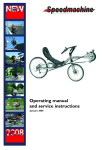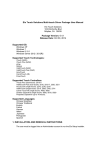Download Instructions
Transcript
Instructions for proper usage of mechanical wheelchair IRIS CONTENTS Dear user, The mechanical wheelchair KURY is constructed in a way to meet the highest requirements of quality, functionality, safety and design. The wheelchair is made of light aluminum alloys and that is why it requires proper usage and common every-day maintenance. Please read all usage instructions before you start to use the wheelchair. According to §12 clause 2 law no. 22/1999 Coll. about the assessment of the conformity of rehabilitation aids and declaration of conformity, and according to §7-10 of government ordinance no. 180/1998 Coll. and appendix no. 1 of this ordinance, and according to §13 of law no. 22/1997 Coll. and §11 of government ordinance and in accordance with European directive 93/42 EHS, there has been an assessment of conformity of their properties with the requirements for the safety of the product included in this user’s manual. ? We will gladly answer all your possible questions on phone +420 466 936 139 or on the company website www.kury.cz. CONTENTS WHEELCHAIR DESIGN 3 WHEELCHAIR ADJUSTMENT AND MANIPULATION [1] BACK REST TILTING 4 [2] REMOVING THE REAR WHEEL 5 [3] REPLACEMENT OF THE REAR WHEEL CASING – SETTING THE WHEEL ANGLE 5 [4] SETTING THE HEIGHT AND THE ANGLE OF THE FOOT REST 6 [5] SETTING THE TEXTILE PADDING AND THE BACK REST 7 [6] BRAKES – ADJUSTMENT OF THE PRESSURE OF THE BRAKE PIN 7 [7] ADJUSTMENT OF THE CENTRE OF GRAVITY / ADJUSTMENT OF THE SEAT 8 [8] PUSH RIMS 9 [9] REAR WHEEL SPOKE PROTECTION 9 BASIC PRINCIPLES OF USING THE WHEELCHAIR 9 PRINCIPLES OF SAFETY 10 STORAGE AND MAINTENANCE 11 WARRANTY 11 SERVICE 12 DESIGN OF THE MECHANICAL WHEELCHAIR IRIS DESCRIPTION OF THE BASIC PARTS C A WHEELCHAIR FRAME F FRONT WHEEL B SEAT G FOOT REST C BACK REST H BRAKE D MUD GUARD I TEXTILE PARTS E REAR WHEEL J PUSH RIMS I D H B A J G E F W H E E L C H A I R M A N I P U L AT I O N 1 TILTING OF THE BACK REST To adjust or tilt the back rest, use the elastic drawbar. Pull at the wire – the securing pins will loosen and you will be able to set the angle of the back rest (8 degrees forward, 8 degrees backward) or tilt the back rest completely (see photo). -8° 90° +8° The hole on at the bottom of the section of the seat holder (see the arrow) serves to secure the tilted back rest and makes further manipulation with the wheelchair possible Provided that safety is ensured, it is possible to adjust the angle of the back rest while sitting on the wheelchair. ADJUSTMENT OF THE WHEELCHAIR 2 REMOVING THE REAR WHEEL 1. Make sure that the wheel is not stalled. 2. Press the button at the centre of the wheel by your thumb. Put the other fingers under the spokes and pull lightly at the wheel along the axis. 3. To attach the wheel back on the wheelchair, please follow the instructions in reverse order. The central button has to be pressed! 3 REPLACING THE CASING OF THE REAR WHEEL Replacing the casing of the rear wheel with the possibility of adjusting the angle of the rear wheels (0 to 4 degrees) Loosen the sleeve – use hexagon key no. 5. Pull the sleeve out. Using the rear wheel axle pull out the original casing. Insert the casing with the desired tilting angle. Use a wrench no. 17 for an exact adjustment of the guiding mark towards the groove on the tube of the frame. Pull the sleeve back on and tighten it with hexagon key no. 5. ADJUSTMENT OF THE WHEELCHAIR 4 ADJUSTING THE FOOT REST Setting the height of the foot rest On both sides of the wheelchair frame, loosen the bolts (M5) and remove them. Pull the sides of the footrest on both sides in or out to the desired height. Put the bolts back in and secure them with a selfsecuring nut. Setting the angle of the foot rest se the hexagon key no. 5 to loosen the U bolts in both holders. Set the angle of the footrest as you desire and then firmly tighten the bolts again. ADJUSTMENT OF THE WHEELCHAIR 5 ADJUSTING THE TEXTILE PARTS Setting the firmness of the textile padding of the back rest By using the clasps and Velcro adjust the tension in the back rest as you desire. Fasten the textile back rest as you desire. 6 ADJUSTING THE BRAKES Adjusting the pressure of the brake pin Loosen the bolt M8 and move the whole brake towards the wheel. Tighten the nut lightly. Check the pressure. Tighten the nut firmly. ADJUSTMENT OF THE WHEELCHAIR 7 ADJUSTING THE CENTRE OF GRAVITY Wheelchair IRIS has a firmly defined frame. The size (diameter) of the wheels: - front wheels R 100/125 - rear wheels R 24 x 1” or R 24 x 1and 3/8” By moving the fixation of the front wheel in the fork, the centre of gravity moves towards the rear wheel. The adjustment of the height of the seat together with the back rest is done by moving parts “A” and “B” (see picture) as the user needs. A If the structure of the seat frame is moved towards the back (by part “B”), the centre of gravity shifts towards the rear wheel. B USING THE WHEELCHAIR 8 PUSH RIMS There are two types of push rims: - aluminum with elox coating - stainless - coated with softened plastic Stainless push rims can be repaired. Aluminum push rims, if the elox coating is damaged, can make the hands dirty and cannot be repaired. Coated push rims cannot be repaired. 9 PROTECTORS OF THE SPOKES OF THE REAR The protectors of the spokes of the rear wheels serve to protect the palms and fingers in case of unexpected movement of the wheelchair and prevent the hands from getting into the spokes if the wheel. They cannot be damaged by hands. STATIC STABILITY Problems with static stability may be caused by the user’s inadequate way of sitting on the wheelchair, which decreases its overall stability. • Do not lean extremely outwards from the wheelchair, avoid sudden energetic movements or leaning directly against the footrests. • When riding down a slope, use the push rims to control the speed, do not use the brakes – it can be dangerous! USING THE WHEELCHAIR Dynamic stability: When riding up a slope or overcoming a frontal obstruction, it is recommended to lean slightly forward. slightly forwards. Then give another impulse to come to the obstruction with the rear wheels, too. If the obstruction is not very high, it is sometimes better to get down When riding down a slope and overcoming the slope with your back first with your a frontal obstruction, lean slightly body leaning slightly towards the slope backwards. At the same time always control (forwards). the driving wheels and be ready to use the push rims to brake. When overcoming an obstruction both up a slope or down a slope: both wheels have When riding up or down a slope, keep in to get over the obstruction at the same mind the possible unevenness of the surface time. and make sure to avoid a collision and turning the wheelchair over. Never underestimate obstructions, if necessary, always ask another person for When overcoming a frontal obstruction help. stop directly in front of it and make sure that you do not hit the obstruction with Do not go down the stairs without the help the foot-rests (the wheelchair could turn of another person. over, especially when riding down a slope). Before using the wheelchair outdoors it is Move the driving wheels with an impulse recommended that you acquire certain skills in a way that the front wheels come onto and abilities. the obstruction first, leaning your body SAFETY RULES • When getting on and off the wheelchair: - Have both wheels stalled (there is a danger of the wheel getting away and a fall) - Have the foot-rests folded up (it will make getting on and off the wheelchair easier) • Before a ride - check the air pressure in the tires - check the function of the brakes - check the condition of the textile parts and the arm rests • While riding: - be careful if the terrain is steep - do not lean against the footrests with all your weight - avoid sudden energetic movements that could break the stability of the wheelchair - if necessary, always get another person to help you 10 M A I N T E N A N C E / G UA R A N T E E STORAGE AND MAINTENANCE Store your wheelchair in a dry and dust-free place. Improper storage (cellars, garages etc.) can result in malfunction of the wheelchair and thus may cause danger. Continuous maintenance • after riding in rain or snow, wipe all the parts of the wheelchair dry Weekly maintenance • check the pressure in the tires, if necessary, inflate the tires to 0,3 MPa (rear wheels) • clean the textile parts using common cleansing articles to clean upholstery, and lukewarm water • clean the metal parts of the wheelchair with dry cloth and non-aggressive cleaning materials for cleaning metal. • check the function of the brakes Monthly maintenance: • weekly check-up • check the allowance of the front and rear wheels • check the allowance of the forks of the front wheels • check the wear of the textile parts • oil the axle of the rear wheel using standard oil for bicycles Yearly maintenance • Once a year, we recommend that a check-up, adjustment and servicing be done at an authorized service station. • check the wear of the tires GUARANTEE The guarantee of the mechanical wheelchair is provided for 24 months from the date of purchase. • The guarantee is applicable only to defects of the product caused by a defect of the material or a production flaw. • The guarantee is not applicable to damage caused by incorrect usage of the wheelchair, incorrect maintenance and common wear of the wheelchair. The guarantee expires if the repairs have been carried out by an unauthorized person or by using spare parts that are not original. 11 SERVICE To use the service, please contact the manufacturer – the company KURY: • tel.: +420 466 936 139 • fax: +420 466 936 138 • email: [email protected] • web: www.kury.cz • adresa: KURY spol. s r.o. Zdechovice 28 533 11 Zdechovice Czech Republic This instruction manual may depict models with optional accessories that do not necessarily have to be a part of the standard equipment. With regard to development, the manufacturer reserves the right to alter construction parameters without prior notice. © 2008 KURY spol. s r.o. Made in Czech Republic.


















